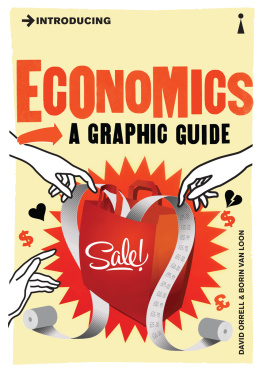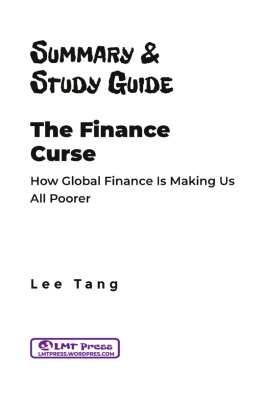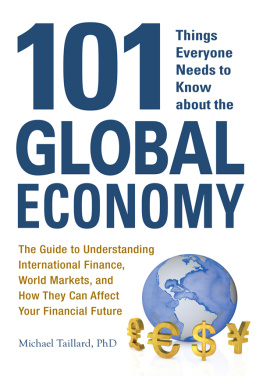
This edition first published 2017
2017 Paul Wilmott and David Orrell
Registered office
John Wiley & Sons Ltd, The Atrium, Southern Gate, Chichester, West Sussex, PO19 8SQ, United Kingdom
For details of our global editorial offices, for customer services and for information about how to apply for permission to reuse the copyright material in this book please see our website at www.wiley.com.
All rights reserved. No part of this publication may be reproduced, stored in a retrieval system, or transmitted, in any form or by any means, electronic, mechanical, photocopying, recording or otherwise, except as permitted by the UK Copyright, Designs and Patents Act 1988, without the prior permission of the publisher.
Wiley publishes in a variety of print and electronic formats and by print-on-demand. Some material included with standard print versions of this book may not be included in e-books or in print-on-demand. If this book refers to media such as a CD or DVD that is not included in the version you purchased, you may download this material at http://booksupport.wiley.com. For more information about Wiley products, visit www.wiley.com.
Designations used by companies to distinguish their products are often claimed as trademarks. All brand names and product names used in this book are trade names, service marks, trademarks or registered trademarks of their respective owners. The publisher is not associated with any product or vendor mentioned in this book.
Limit of Liability/Disclaimer of Warranty: While the publisher and author have used their best efforts in preparing this book, they make no representations or warranties with respect to the accuracy or completeness of the contents of this book and specifically disclaim any implied warranties of merchantability or fitness for a particular purpose. It is sold on the understanding that the publisher is not engaged in rendering professional services and neither the publisher nor the author shall be liable for damages arising herefrom. If professional advice or other expert assistance is required, the services of a competent professional should be sought.
A catalogue record for this book is available from the Library of Congress.
A catalogue record for this book is available from the British Library.
ISBN 978-1-119-35861-9 (paperback) ISBN 978-1-119-35866-4 (ebk)
ISBN 978-1-119-35868-8 (ebk)ISBN 978-1-119-35872-5 (ebk)
Cover design concept: Beatriz Leon
To Oscar, Zachary, Genevieve, and Horatio
Paul Wilmott
To Wendy and Katherine
David Orrell
Acknowledgements
The authors would like to thank publisher Thomas Hyrkiel, project editor Jeremy Chia, production editor Samantha Hartley, and the rest of the Wiley team. Thanks also to Seth Ditchik, Ed Howker, Julia Kingsford, Robert Lecker, Beatriz Leon, Robert Matthews, Myles Thompson, and Andrea Wilmott.
About the Authors
Paul Wilmott is a mathematician and serial entrepreneur. His textbooks and educational programs provide the definitive training for quants; his website wilmott.com is the center of the quant community; his eponymous bi-monthly and according to Esquire the world's most expensive magazine is a quant must-have. As a practitioner he has been a consultant to leading financial institutions and managed his own hedge fund. As a commentator he has appeared on many TV and radio programs and written OpEds for the New York Times. Nassim Nicholas Taleb calls him the smartest quant in the world: He's the only one who truly understands what's going on the only quant who uses his own head and has any sense of ethics. Paul divides his time between London, the Cotswolds, and New York.
David Orrell is an applied mathematician and writer. Founder of the scientific consultancy Systems Forecasting, his scientific work has encompassed diverse areas such as particle accelerator design, weather prediction, cancer biology, and economics. His books on subjects including prediction, economics, and science have been national bestsellers and have been translated into over ten languages. A revised and expanded version of his book Economyths: 11 Ways That Economics Gets it Wrong is also published this year. He lives in Toronto.
Introduction
How about the scandalous stories of thousands of families with small and medium investments who have been ruined because of the greed of financial institutions in the United States and Europe. Look at the evictions, ruined families, and suicide attempts caused by the financial crisis of those who have failed to control the capital markets or the prices of raw materials. Vaya mierda!
Response to the survey question: Do you have any outrageous or hilarious stories that you think ought to be in Paul and David's new book? Share some details, please! at wilmott.com
The truth about their motivation in writing.
Response to the survey question: What topics should definitely feature in the book? at wilmott.com
The global financial crisis that peaked in late 2008, and whose aftershocks have yet to fully dissipate, was the culmination of many years of dubious financial practices. If carried out alone they might have caused only localized harm, but they became aligned in the way that only the most dramatic of astrologers can dream of: a quadrillion dollars in complex financial products that no one understands; risk-management techniques that hide risk rather than decrease it; moral hazard and dangerous incentives; lack of diversification; regulators that are oblivious; mathematicians acting as psychological enablers. It was a story where the nave, the negligent, and the downright nasty all pulled together in seizing as much as possible for themselves while almost destroying the financial foundations of the planet.
Of course, things have moved on since then. The banking system has become even more concentrated. Global debt the engine fuel of finance has grown to unprecedented levels. Markets, in which activity is increasingly dominated by high-frequency-trading robots, experience constant flash events where prices suddenly go wild before returning to more normal levels. The world financial system is once again rattling at its cage, ready to blow. And quantitative finance the use of mathematical models to assist or dictate investment decisions has become more powerful and influential than ever.
The story, in other words, isn't over not by a long shot. Indeed, the stakes have never been higher, which is why previously arcane topics such as hedge funds, high-frequency trading, and too-big-to-fail banks have become a major topic of often-confusing debate for everyone from TV pundits to politicians. And why the confusion is often deliberate.
It has been estimated that in 2010 the notional value of all the financial derivatives in existence was $1.2 quadrillion. That's $1,200,000,000,000,000. For comparison, it's about 17 times the market capitalization of all the world's stock markets, or 150 times the value of the above-ground gold supply, or $170,000 for every living human on the planet. Actually, it's larger than the entire global economy. We'll explain this number, and how it could be interpreted, later. For the moment, let's just say that whatever it means in terms of risk, it seems like a dangerously big number for what is, let's be honest, just a service industry.
This book is not about the fallout from the crisis plenty of books and column inches have been written about that but about helping to prevent the next one (which won't look like the last one). To do that, it is necessary to go into the engine room of this massive shadow economy and understand how quantitative analysis works. How do you create a quadrillion dollars out of nothing, blow it away, and leave a hole so large that even years of the deliberately misnamed quantitative easing can't fill it and then go back to doing the same thing, only faster? Part of a quant's job, as we'll see, is science, and another part (the one where mathematics is used to obfuscate reality) is the opposite of science. We will discuss both, starting with the science.
Next page










